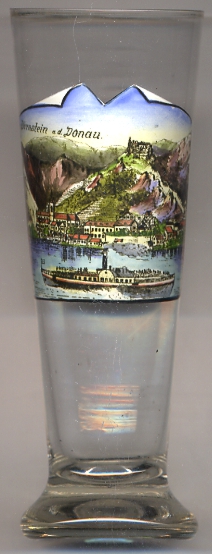

|
| ÖSTERREICH | AUSTRIA |
| Bundesland: Niederösterreich | Lower Austria |
| Bezirk: Krems an der Donau |
 Dürnstein is situated at an elevation of 209 m on the river Danube in the Wachau region of Lower Austria.
The municipality also includes Dürnsteiner Waldhütten, Oberloibén, Rothenhof and Unterloiben.
The population of the municipality is 886 (2014).
Dürnstein is situated at an elevation of 209 m on the river Danube in the Wachau region of Lower Austria.
The municipality also includes Dürnsteiner Waldhütten, Oberloibén, Rothenhof and Unterloiben.
The population of the municipality is 886 (2014).
Loiben was first mentioned in 860 AD in the deed of donation of areas in the Danube valley given to the archbishopric of Salzburg by German King Ludwig II (Ludwig 'the German'). Dürnstein Castle was founded in the mid-12th century by the Kuenringer dynasty. The name Dürnstein was first mentioned in a written document of 1192. The English king Richard I ('the Lionhearted') was imprisoned here between December 1192 and March 1193 (although it is not certain as to whether he was kept prisoner in the castle or in some other place in Dürnstein. The town Dürnstein was first mentioned in 1347. The town was devastated by a large fire in 1551. The castle was blown up by Swedish troops in 1645 during the Thirty Years' War (1618–1648). During the Napoleonic Wars (War of the Third Coalition) Loiben was the site of the Battle of Loiben-Dürnstein (1805). The steam ship landing station was opened in 1902, a water pipeline bring in fresh water from the mountains was created in 1906, the Wachau Railroad was built in 1909. In 1971 the municipality of Loiben was incorporated into he municipality of Dürnstein. Dürnstein and the Wachau region received the European Diploma of Protected Areas in 1994; in 2002 Dürnstein and the Wachau were listed as World Heritage Site by UNESCO. (see also list of other UNESCO heritage sites depicted on glasses of this collection)
The ruins of  Dürnstein castle [top right] are situated high above the town.
The castle was founded in the mid-12th century by the Kuenringer family. Richard the Lionhearted was imprisoned here (or near here) in 1192 by
Duke Leopold V of Austria before being handed over to Emperor Heinrich II in 1193. The castle was fortified in 1588 but finally was blown up
by the Swedes in 1645. Although it could have been repaired this was never done. In 1663 it was used as a place of refuge during the times of the Turkish invasions.
Since about 1679 it finally became uninhabitable and fell into dereliction. Today the castle is one of the best known landmarks of Austria.
Dürnstein castle [top right] are situated high above the town.
The castle was founded in the mid-12th century by the Kuenringer family. Richard the Lionhearted was imprisoned here (or near here) in 1192 by
Duke Leopold V of Austria before being handed over to Emperor Heinrich II in 1193. The castle was fortified in 1588 but finally was blown up
by the Swedes in 1645. Although it could have been repaired this was never done. In 1663 it was used as a place of refuge during the times of the Turkish invasions.
Since about 1679 it finally became uninhabitable and fell into dereliction. Today the castle is one of the best known landmarks of Austria.
[https://de.wikipedia.org/wiki/Dürnstein]
![[scale]](lineal.jpg)